
Illustrative Math Alignment: Grade 7 Unit 7
Expressions, Equations, and Inequalities
Lesson 18: Subtraction in Equivalent Expressions
Use the following Media4Math resources with this Illustrative Math lesson.
| Thumbnail Image | Title | Body | Curriculum Topic |
|---|---|---|---|
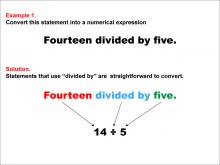
|
Math Example: Language of Math--Numerical Expressions--Division--Example 1 | Math Example: Language of Math--Numerical Expressions--Division--Example 1TopicNumerical Expressions DescriptionThis example demonstrates how to convert the verbal expression "Fourteen divided by five" into a numerical expression. The solution shows that this can be written as 14 / 5 or 14 ÷ 5, illustrating the two common notations for division in mathematics. |
Numerical Expressions |
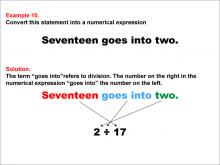
|
Math Example: Language of Math--Numerical Expressions--Division--Example 10 | Math Example: Language of Math--Numerical Expressions--Division--Example 10TopicNumerical Expressions DescriptionThis example explains converting "Seventeen goes into two" into a numerical expression as 2 ÷ 17, demonstrating how verbal cues translate into mathematical operations. The topic of numerical expressions is crucial for understanding math language and operations. These examples guide students through the process of interpreting language mathematically, enhancing their analytical skills. |
Numerical Expressions |
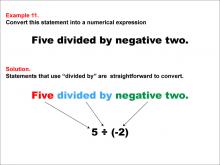
|
Math Example: Language of Math--Numerical Expressions--Division--Example 11 | Math Example: Language of Math--Numerical Expressions--Division--Example 11TopicNumerical Expressions DescriptionThis example demonstrates converting "Five divided by negative two" into a numerical expression, resulting in 5 ÷ (-2). It shows how to handle division with negative numbers. The topic of numerical expressions is essential for understanding mathematical operations and their representations. These examples help students navigate the complexities of translating verbal statements into mathematical expressions, enhancing their problem-solving skills. |
Numerical Expressions |

|
Math Example: Language of Math--Numerical Expressions--Division--Example 12 | Math Example: Language of Math--Numerical Expressions--Division--Example 12TopicNumerical Expressions DescriptionThis example illustrates converting "Eight over negative two" into a numerical expression, resulting in 8 ÷ (-2). It highlights how "over" signifies division. The study of numerical expressions is vital for interpreting mathematical language. These examples provide clarity on how verbal cues translate into math, aiding students in developing analytical skills. |
Numerical Expressions |
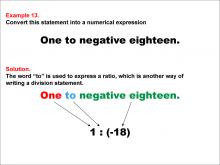
|
Math Example: Language of Math--Numerical Expressions--Division--Example 13 | Math Example: Language of Math--Numerical Expressions--Division--Example 13TopicNumerical Expressions DescriptionThis example shows how to convert "One to negative eighteen" into a numerical expression, resulting in the ratio 1 : (-18). It explains how "to" can express division as a ratio. The topic of numerical expressions is fundamental in understanding mathematical relationships. These examples guide students through interpreting language mathematically, enhancing their analytical skills. |
Numerical Expressions |
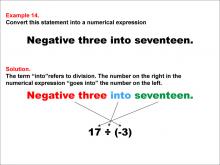
|
Math Example: Language of Math--Numerical Expressions--Division--Example 14 | Math Example: Language of Math--Numerical Expressions--Division--Example 14TopicNumerical Expressions DescriptionThis example demonstrates converting "Negative three into seventeen" into a numerical expression, resulting in 17 ÷ (-3). It clarifies how "into" indicates division. The study of numerical expressions is crucial for understanding math language and operations. Through these examples, students learn how language can be systematically translated into mathematical expressions, aiding their problem-solving skills. |
Numerical Expressions |
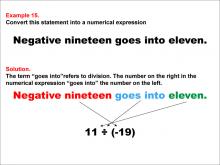
|
Math Example: Language of Math--Numerical Expressions--Division--Example 15 | Math Example: Language of Math--Numerical Expressions--Division--Example 15TopicNumerical Expressions DescriptionThis example shows an example converting "Negative nineteen goes into eleven" into a numerical expression, resulting in 11 ÷ (-19). It explains that "goes into" signifies division. The topic of numerical expressions is essential for understanding mathematical operations and their representations. These examples help students navigate the complexities of translating verbal statements into mathematical expressions, enhancing their problem-solving skills. |
Numerical Expressions |
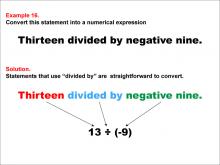
|
Math Example: Language of Math--Numerical Expressions--Division--Example 16 | Math Example: Language of Math--Numerical Expressions--Division--Example 16TopicNumerical Expressions DescriptionThis example provides an example of converting "Thirteen divided by negative nine" into a numerical expression, resulting in 13 ÷ (-9). It notes that "divided by" is straightforward to convert. The study of numerical expressions is vital for interpreting mathematical language. These examples provide clarity on how verbal cues translate into math, aiding students in developing analytical skills. |
Numerical Expressions |

|
Math Example: Language of Math--Numerical Expressions--Division--Example 17 | Math Example: Language of Math--Numerical Expressions--Division--Example 17TopicNumerical Expressions DescriptionThis example explains how to convert "Twenty over negative one" into a numerical expression, resulting in 20 ÷ (-1). The topic of numerical expressions is essential for understanding mathematical operations and their representations. These examples help students navigate the complexities of translating verbal statements into mathematical expressions, enhancing their problem-solving skills. |
Numerical Expressions |
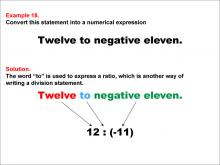
|
Math Example: Language of Math--Numerical Expressions--Division--Example 18 | Math Example: Language of Math--Numerical Expressions--Division--Example 18TopicNumerical Expressions DescriptionThis example shows the conversion of "Twelve to negative eleven" into a numerical expression, resulting in the ratio 12 : (-11). The study of numerical expressions is crucial for understanding math language and operations. Through these examples, students learn how language can be systematically translated into mathematical expressions, aiding their problem-solving skills. |
Numerical Expressions |
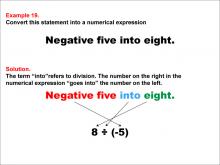
|
Math Example: Language of Math--Numerical Expressions--Division--Example 19 | Math Example: Language of Math--Numerical Expressions--Division--Example 19TopicNumerical Expressions DescriptionThis image demonstrates converting "Negative five into eight" into a numerical expression, resulting in 8 ÷ (-5). The topic of numerical expressions is essential for understanding mathematical operations and their representations. These examples help students navigate the complexities of translating verbal statements into mathematical expressions, enhancing their problem-solving skills. |
Numerical Expressions |
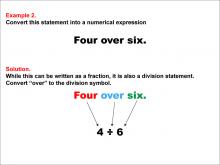
|
Math Example: Language of Math--Numerical Expressions--Division--Example 2 | Math Example: Language of Math--Numerical Expressions--Division--Example 2TopicNumerical Expressions DescriptionThis example illustrates the conversion of the verbal expression "Four over six" into a numerical expression. The solution demonstrates that this can be written as 4 / 6 or 4 ÷ 6, showcasing two common ways to represent division in mathematics. |
Numerical Expressions |

|
Math Example: Language of Math--Numerical Expressions--Division--Example 20 | Math Example: Language of Math--Numerical Expressions--Division--Example 20TopicNumerical Expressions DescriptionThis image describes how to convert "Negative four goes into four" into a numerical expression, resulting in 4 ÷ (-4). It clarifies that "goes into" indicates division. The study of numerical expressions is crucial for understanding math language and operations. Through these examples, students learn how language can be systematically translated into mathematical expressions, aiding their problem-solving skills. |
Numerical Expressions |
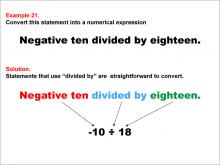
|
Math Example: Language of Math--Numerical Expressions--Division--Example 21 | Math Example: Language of Math--Numerical Expressions--Division--Example 21TopicNumerical Expressions DescriptionThis example shows the conversion of "Negative ten divided by eighteen" into a numerical expression, resulting in -10 ÷ 18. The topic of numerical expressions is essential for understanding mathematical operations and their representations. These examples help students navigate the complexities of translating verbal statements into mathematical expressions, enhancing their problem-solving skills. |
Numerical Expressions |
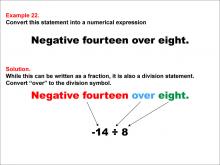
|
Math Example: Language of Math--Numerical Expressions--Division--Example 22 | Math Example: Language of Math--Numerical Expressions--Division--Example 22TopicNumerical Expressions DescriptionThis example illustrates converting "Negative fourteen over eight" into a numerical expression, resulting in -14 ÷ 8. The study of numerical expressions is vital for interpreting mathematical language. These examples provide clarity on how verbal cues translate into math, aiding students in developing analytical skills. Multiple worked-out examples are important for deep understanding. They offer diverse perspectives on solving problems, helping students build a robust understanding that can be applied across various contexts. |
Numerical Expressions |
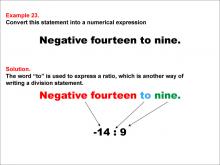
|
Math Example: Language of Math--Numerical Expressions--Division--Example 23 | Math Example: Language of Math--Numerical Expressions--Division--Example 23TopicNumerical Expressions DescriptionThis example shows the conversion of "Negative fourteen to nine" into a numerical expression, resulting in -14 : 9. The study of numerical expressions is crucial for understanding math language and operations. Through these examples, students learn how language can be systematically translated into mathematical expressions, aiding their problem-solving skills. |
Numerical Expressions |
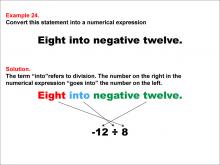
|
Math Example: Language of Math--Numerical Expressions--Division--Example 24 | Math Example: Language of Math--Numerical Expressions--Division--Example 24TopicNumerical Expressions DescriptionThis example shows the conversion of "Eight into negative twelve" into a numerical expression, resulting in -12 ÷ 8. It explains how "into" indicates division. The study of numerical expressions is crucial for understanding math language and operations. Through these examples, students learn how language can be systematically translated into mathematical expressions, aiding their problem-solving skills. |
Numerical Expressions |
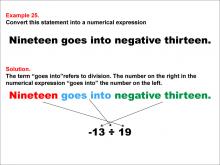
|
Math Example: Language of Math--Numerical Expressions--Division--Example 25 | Math Example: Language of Math--Numerical Expressions--Division--Example 25TopicNumerical Expressions DescriptionThis example shows how to convert "Nineteen goes into negative thirteen" into a division expression, resulting in -13 ÷ 19. The term "goes into" indicates division. The study of numerical expressions is crucial for understanding math language and operations. Through these examples, students learn how language can be systematically translated into mathematical expressions, aiding their problem-solving skills. |
Numerical Expressions |
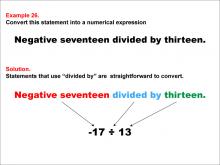
|
Math Example: Language of Math--Numerical Expressions--Division--Example 26 | Math Example: Language of Math--Numerical Expressions--Division--Example 26TopicNumerical Expressions DescriptionThis example demonstrates converting "Negative seventeen divided by thirteen" into a numerical expression, resulting in -17 ÷ 13. Statements with "divided by" are straightforward to convert. The topic of numerical expressions is essential for understanding mathematical operations and their representations. These examples help students navigate the complexities of translating verbal statements into mathematical expressions, enhancing their problem-solving skills. |
Numerical Expressions |
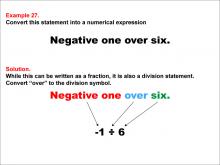
|
Math Example: Language of Math--Numerical Expressions--Division--Example 27 | Math Example: Language of Math--Numerical Expressions--Division--Example 27TopicNumerical Expressions DescriptionThis example illustrates converting "Negative one over six" into a division expression, resulting in -1 ÷ 6. The word "over" is used for division. The study of numerical expressions is vital for interpreting mathematical language. These examples provide clarity on how verbal cues translate into math, aiding students in developing analytical skills. Multiple worked-out examples are important for deep understanding. They offer diverse perspectives on solving problems, helping students build a robust understanding that can be applied across various contexts. |
Numerical Expressions |
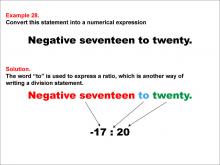
|
Math Example: Language of Math--Numerical Expressions--Division--Example 28 | Math Example: Language of Math--Numerical Expressions--Division--Example 28TopicNumerical Expressions DescriptionThis example explains converting "Negative seventeen to twenty" into a ratio expression, resulting in -17 : 20. The word "to" indicates a ratio, which is a form of division. The study of numerical expressions is crucial for understanding math language and operations. Through these examples, students learn how language can be systematically translated into mathematical expressions, aiding their problem-solving skills. |
Numerical Expressions |

|
Math Example: Language of Math--Numerical Expressions--Division--Example 29 | Math Example: Language of Math--Numerical Expressions--Division--Example 29TopicNumerical Expressions DescriptionThis image explains converting a verbal statement into a division expression, resulting in -14 ÷ 14. The phrase "Fourteen into negative fourteen" is expressed as -14 ÷ 14. The study of numerical expressions is crucial for understanding math language and operations. Through these examples, students learn how language can be systematically translated into mathematical expressions, aiding their problem-solving skills. |
Numerical Expressions |
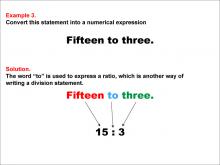
|
Math Example: Language of Math--Numerical Expressions--Division--Example 3 | Math Example: Language of Math--Numerical Expressions--Division--Example 3TopicNumerical Expressions DescriptionThis example demonstrates the conversion of the verbal expression "Fifteen to three" into a numerical expression. The solution shows that this can be written as 15 / 3 or 15 ÷ 3, illustrating two common notations for division in mathematics. |
Numerical Expressions |
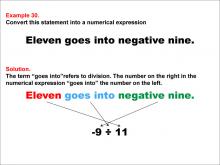
|
Math Example: Language of Math--Numerical Expressions--Division--Example 30 | Math Example: Language of Math—-Numerical Expressions—-Division—-Example 30TopicNumerical Expressions DescriptionThis image describes converting a statement using "goes into" to a division expression, resulting in -9 ÷ 11. The phrase "Eleven goes into negative nine" is expressed as -9 ÷ 11. The study of numerical expressions is crucial for understanding math language and operations. Through these examples, students learn how language can be systematically translated into mathematical expressions, aiding their problem-solving skills. |
Numerical Expressions |
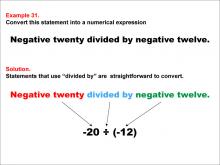
|
Math Example: Language of Math--Numerical Expressions--Division--Example 31 | Math Example: Language of Math—-Numerical Expressions—-Division—-Example 31TopicNumerical Expressions DescriptionThis image shows converting a statement with "divided by" into a numerical expression, resulting in -20 ÷ (-12). The phrase "Negative twenty divided by negative twelve" is expressed as -20 ÷ (-12). The topic of numerical expressions is essential for understanding mathematical operations and their representations. These examples help students navigate the complexities of translating verbal statements into mathematical expressions, enhancing their problem-solving skills. |
Numerical Expressions |
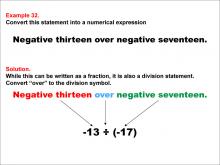
|
Math Example: Language of Math--Numerical Expressions--Division--Example 32 | Math Example: Language of Math--Numerical Expressions--Division--Example 32Numerical ExpressionsTopic Description
This example demonstrates how to convert the verbal expression "negative thirteen over negative seventeen" into a mathematical expression. The correct numerical representation is -13 / (-17), which can also be written as -13 ÷ (-17). This conversion helps students understand how to translate verbal descriptions of division operations involving negative numbers into proper mathematical notation. |
Numerical Expressions |
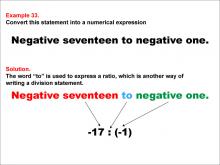
|
Math Example: Language of Math--Numerical Expressions--Division--Example 33 | Math Example: Language of Math--Numerical Expressions--Division--Example 33Numerical ExpressionsTopic Description
This example illustrates the conversion of the verbal expression "negative seventeen to negative one" into a mathematical expression. The correct numerical representation is -17 / (-1) or -17 ÷ (-1). This example helps students understand how to interpret the word "to" as an indicator of division when working with negative numbers. |
Numerical Expressions |
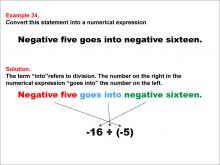
|
Math Example: Language of Math--Numerical Expressions--Division--Example 34 | Math Example: Language of Math--Numerical Expressions--Division--Example 34Numerical ExpressionsTopic Description
This example demonstrates how to convert the verbal expression "negative five goes into negative sixteen" into a mathematical expression. The correct numerical representation is -16 / (-5) or -16 ÷ (-5). This example helps students understand how to interpret the phrase "goes into" as an indicator of division when working with negative numbers. |
Numerical Expressions |

|
Math Example: Language of Math--Numerical Expressions--Division--Example 35 | Math Example: Language of Math--Numerical Expressions--Division--Example 35Numerical ExpressionsTopic DescriptionThis example illustrates the conversion of the verbal expression "negative twenty goes into negative seven" into a mathematical expression. The correct numerical representation is -7 / (-20) or -7 ÷ (-20). This example helps students understand how to interpret the phrase "goes into" as an indicator of division when working with negative numbers, and how the order of the numbers affects the expression. |
Numerical Expressions |

|
Math Example: Language of Math--Numerical Expressions--Division--Example 36 | Math Example: Language of Math--Numerical Expressions--Division--Example 36Numerical ExpressionsTopic DescriptionThis example demonstrates how to convert the verbal expression "negative twenty divided by negative twelve" into a mathematical expression. The correct numerical representation is -20 / (-12) or -20 ÷ (-12). This example helps students understand how to interpret the phrase "divided by" when working with negative numbers. |
Numerical Expressions |
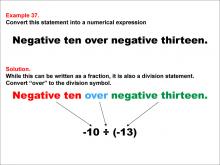
|
Math Example: Language of Math--Numerical Expressions--Division--Example 37 | Math Example: Language of Math--Numerical Expressions--Division--Example 37Numerical ExpressionsTopic DescriptionThis example illustrates the conversion of the verbal expression "negative ten over negative thirteen" into a mathematical expression. The correct numerical representation is -10 / (-13) or -10 ÷ (-13). This example helps students understand how to interpret the word "over" as an indicator of division when working with negative numbers. |
Numerical Expressions |

|
Math Example: Language of Math--Numerical Expressions--Division--Example 38 | Math Example: Language of Math--Numerical Expressions--Division--Example 38Numerical ExpressionsTopic DescriptionThis example demonstrates how to convert the verbal expression "negative eleven to negative three" into a mathematical expression. The correct numerical representation is -11 / (-3) or -11 ÷ (-3). This example helps students understand how to interpret the word "to" as an indicator of division when working with negative numbers. |
Numerical Expressions |
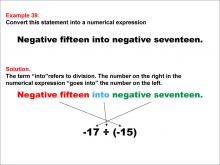
|
Math Example: Language of Math--Numerical Expressions--Division--Example 39 | Math Example: Language of Math--Numerical Expressions--Division--Example 39TopicNumerical Expressions DescriptionThis math example demonstrates how to convert the phrase "Negative fifteen into negative seventeen" into a numerical expression. The problem involves dividing negative numbers, specifically -15 ÷ -17. This example helps students understand how to interpret verbal descriptions of mathematical operations and translate them into proper numerical expressions. |
Numerical Expressions |
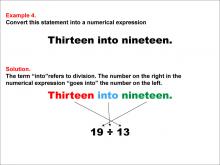
|
Math Example: Language of Math--Numerical Expressions--Division--Example 4 | Math Example: Language of Math--Numerical Expressions--Division--Example 4TopicNumerical Expressions DescriptionThis example illustrates the conversion of the verbal expression "Thirteen into nineteen" into a numerical expression. The solution demonstrates that this can be written as 19 / 13 or 19 ÷ 13, showcasing two common ways to represent division in mathematics. |
Numerical Expressions |
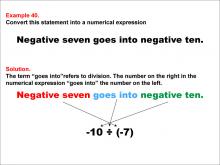
|
Math Example: Language of Math--Numerical Expressions--Division--Example 40 | Math Example: Language of Math--Numerical Expressions--Division--Example 40TopicNumerical Expressions DescriptionThis math example illustrates the process of converting the phrase "Negative seven goes into negative ten" into a numerical expression. The problem involves dividing negative numbers, specifically -10 ÷ -7. This example helps students understand how to interpret verbal descriptions of mathematical operations and translate them into proper numerical expressions, particularly when dealing with negative numbers and division. |
Numerical Expressions |

|
Math Example: Language of Math--Numerical Expressions--Division--Example 5 | Math Example: Language of Math--Numerical Expressions--Division--Example 5TopicNumerical Expressions DescriptionThis example demonstrates how to convert the verbal expression "Fourteen goes into seven" into a numerical expression. The solution shows that this can be written as 7 / 14 or 7 ÷ 14, illustrating the two common notations for division in mathematics. |
Numerical Expressions |
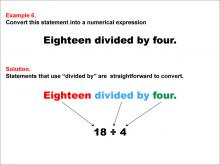
|
Math Example: Language of Math--Numerical Expressions--Division--Example 6 | Math Example: Language of Math--Numerical Expressions--Division--Example 6TopicNumerical Expressions DescriptionThis example demonstrates converting the phrase "Eighteen divided by four" into a numerical expression, resulting in 18 ÷ 4. It illustrates how verbal statements can be directly translated into mathematical expressions using division. |
Numerical Expressions |
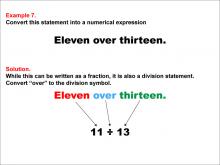
|
Math Example: Language of Math--Numerical Expressions--Division--Example 7 | Math Example: Language of Math--Numerical Expressions--Division--Example 7TopicNumerical Expressions DescriptionThis example illustrates converting "Eleven over thirteen" into a numerical expression using division, resulting in 11 ÷ 13. It shows how phrases involving fractions can be interpreted as division expressions. The topic of numerical expressions is foundational in mathematics, and these examples provide clarity on how language translates into math. By exploring various examples, students gain insight into different ways mathematical concepts are expressed verbally, enhancing their comprehension and skills. |
Numerical Expressions |
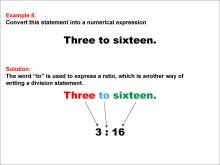
|
Math Example: Language of Math--Numerical Expressions--Division--Example 8 | Math Example: Language of Math--Numerical Expressions--Division--Example 8TopicNumerical Expressions DescriptionThis example explains how to interpret ratios as division expressions using the phrase "Three to sixteen," which converts to the numerical form 3 : 16. The topic of numerical expressions is vital in understanding mathematical relationships. These examples help students connect verbal descriptions with mathematical operations, reinforcing their ability to translate language into math accurately. |
Numerical Expressions |

|
Math Example: Language of Math--Numerical Expressions--Division--Example 9 | Math Example: Language of Math--Numerical Expressions--Division--Example 9TopicNumerical Expressions DescriptionThis example shows how to convert "Three into eighteen" into a numerical expression using division, represented as 18 ÷ 3. It clarifies how specific language cues indicate mathematical operations. The study of numerical expressions is fundamental in mathematics education. Through these examples, students learn how language can be systematically translated into mathematical expressions, aiding their problem-solving skills. |
Numerical Expressions |
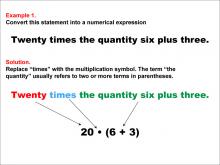
|
Math Example: Language of Math--Numerical Expressions--Grouping Symbols--Example 1 | Math Example: Language of Math--Numerical Expressions--Grouping Symbols--Example 1TopicNumerical Expressions DescriptionThis math example demonstrates how to convert the verbal statement "Twenty times the quantity six plus three" into a numerical expression. The solution shows that this statement can be expressed as 20 * ( 6 + 3 ). This example illustrates the use of grouping symbols (parentheses) to clarify the order of operations in a numerical expression. |
Numerical Expressions |
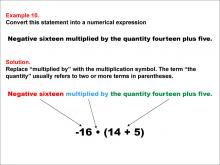
|
Math Example: Language of Math--Numerical Expressions--Grouping Symbols--Example 10 | Math Example: Language of Math--Numerical Expressions--Grouping Symbols--Example 10TopicNumerical Expressions DescriptionThis example illustrates the conversion of the verbal statement "Negative sixteen multiplied by the quantity fourteen plus five" into the numerical expression -16 * (14 + 5). The process involves replacing "multiplied by" with the multiplication symbol and using parentheses to group the terms following "the quantity." |
Numerical Expressions |

|
Math Example: Language of Math--Numerical Expressions--Grouping Symbols--Example 11 | Math Example: Language of Math--Numerical Expressions--Grouping Symbols--Example 11TopicNumerical Expressions DescriptionThis example demonstrates the conversion of the verbal statement "Negative nineteen divided by the quantity sixteen plus seven" into the numerical expression -19 / (16 + 7). The process involves replacing "divided by" with the division symbol and using parentheses to group the terms following "the quantity." |
Numerical Expressions |
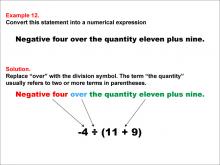
|
Math Example: Language of Math--Numerical Expressions--Grouping Symbols--Example 12 | Math Example: Language of Math--Numerical Expressions--Grouping Symbols--Example 12TopicNumerical Expressions DescriptionThis example illustrates the conversion of the verbal statement "Negative four over the quantity eleven plus nine" into the numerical expression -4 / (11 + 9). The process involves replacing "over" with the division symbol and using parentheses to group the terms following "the quantity." |
Numerical Expressions |
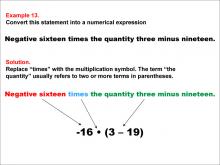
|
Math Example: Language of Math--Numerical Expressions--Grouping Symbols--Example 13 | Math Example: Language of Math--Numerical Expressions--Grouping Symbols--Example 13TopicNumerical Expressions DescriptionThis example demonstrates the conversion of the verbal statement "Negative sixteen times the quantity three minus nineteen" into the numerical expression -16 * (3 - 19). The process involves replacing "times" with the multiplication symbol and using parentheses to group the terms following "the quantity." |
Numerical Expressions |
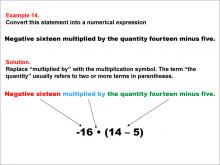
|
Math Example: Language of Math--Numerical Expressions--Grouping Symbols--Example 14 | Math Example: Language of Math--Numerical Expressions--Grouping Symbols--Example 14TopicNumerical Expressions DescriptionThis example illustrates the conversion of the verbal statement "Negative sixteen multiplied by the quantity fourteen minus five" into the numerical expression -16 * (14 - 5). The process involves replacing "multiplied by" with the multiplication symbol and using parentheses to group the terms following "the quantity." |
Numerical Expressions |

|
Math Example: Language of Math--Numerical Expressions--Grouping Symbols--Example 15 | Math Example: Language of Math--Numerical Expressions--Grouping Symbols--Example 15TopicNumerical Expressions DescriptionThis example illustrates converting the verbal statement "Negative nineteen divided by the quantity sixteen minus seven" into a numerical expression. The expression is written as -19 / (16 - 7), using division and grouping symbols to clearly indicate the order of operations. |
Numerical Expressions |

|
Math Example: Language of Math--Numerical Expressions--Grouping Symbols--Example 16 | Math Example: Language of Math--Numerical Expressions--Grouping Symbols--Example 16TopicNumerical Expressions DescriptionThis example shows how to convert "Negative four over the quantity eleven minus nine" into a numerical expression. The expression is written as -4 / (11 - 9), using division and grouping symbols to clarify the order of operations. |
Numerical Expressions |

|
Math Example: Language of Math--Numerical Expressions--Grouping Symbols--Example 17 | Math Example: Language of Math--Numerical Expressions--Grouping Symbols--Example 17TopicNumerical Expressions DescriptionThis example demonstrates converting "Negative six times the quantity negative one plus eight" into a numerical expression. The expression is written as -6 * (-1 + 8), using multiplication and grouping symbols to clearly show the order of operations. |
Numerical Expressions |
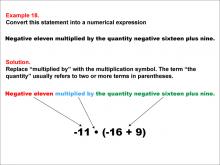
|
Math Example: Language of Math--Numerical Expressions--Grouping Symbols--Example 18 | Math Example: Language of Math--Numerical Expressions--Grouping Symbols--Example 18TopicNumerical Expressions DescriptionThis example illustrates how to convert "Negative eleven multiplied by the quantity negative sixteen plus nine" into a numerical expression. The expression is written as -11 * (-16 + 9), using multiplication and grouping symbols to indicate the order of operations. |
Numerical Expressions |